Since moving to New Zealand my parents have become avid bird-watchers. Not the kind that like to buy extensive equipment and travel great distances to spot some rare species, but more the type who like to relax on their back porch with a glass of wine, and enjoy the birds in their garden. My mom has put in quite a bit of effort into making her garden a paradise for a great variety of birds, so there is always something to see. Even from sitting in the living room she is so happy pointing out the various types of birds, that when I asked her how many different kinds she had, she listed more than a dozen right off the top of her head. I was so amazed, I had to write them all down, extending the list to seventeen different types. Enough to fill a whole post with!
The Most Usual Suspects
Before getting into the cool New Zealand species, I want to tick off the birds you can find virtually anywhere in the world. Like, who doesn’t have sparrows? (Supposedly Perth, Western Australia, but that is a clear exception.) Also, the common blackbird (Turdus merula) I remember having around in Germany, the States, and even Japan.
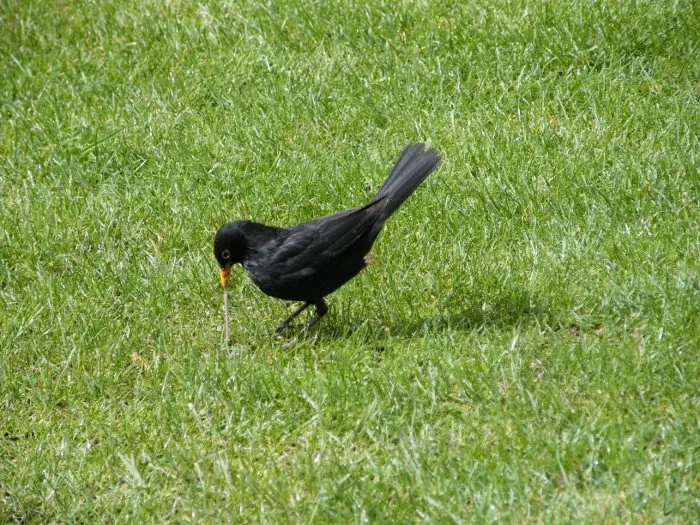
Sure, there are numerous distinctions in species, subspecies, and varieties, so I could probably sit here forever if I wanted to do justice to the proper taxonomy. Not to mention that it has been done before, and volumes have been filled discussing the distinction and relationships between various types of finches. So I’m not even going to attempt that. Instead, I’d like to pass on the joy my mom is getting out of watching a small cloud of finches hopping through her yard, with their little red heads looking like a kindergarten group. So cute! Or the song thrush (Turdus philomelos) she likes to distinguish from the blackbird (to which it is closely related) by its dotted belly.
Birds No One Else Has!
But then there are some birds that you won’t find anywhere else, which are just as common here as the sparrows or blackbirds. The tui (Prosthemadera novaeseelandiae) may be the most prominent one, and with its shiny black feathers, shimmering green and blue in the sun, and a tuft of white at its neck, it is quite a beauty to look at. This honeyeater feeds on the nectar of the many flowers growing year-round on all the trees around the house, and it fills the air with a wide range of sounds. Some of its whistles and flute-like melodies sound quite lovely, while at the same time they like to mix in raspy noises and knocking-like sounds. Often, you can see them opening their beaks, but not hear a thing, as they probably play on a frequency inaudible for us.
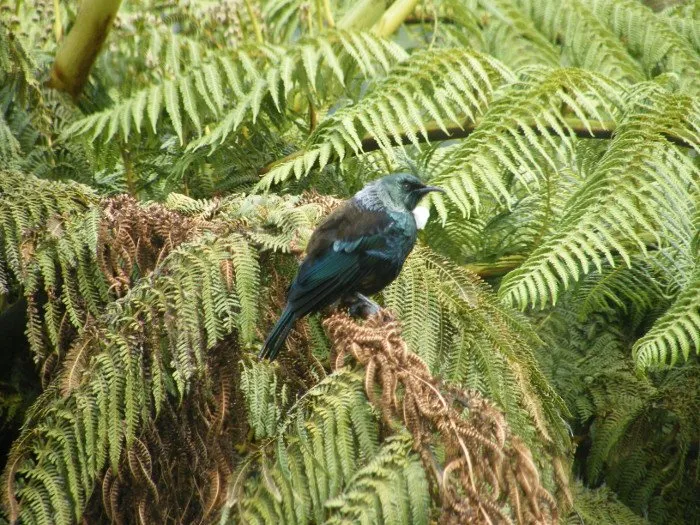
Another close relative to the tui, also endemic to New Zealand and quite abundant in my mom’s garden, is the bellbird (Anthornis melanura). At first she referred to it as the "rusty swing bird” because its song sounded like the squeak of a playground swing that was in bad need of some oil. In its appearance it has an olive colored body, and a matching red eye.
When talking about endemic birds, I should not forget the kereru (Hemiphaga novaeseelandiae), even though it only comes around during the warmer seasons, when the trees are bearing fruit. Also known as New Zealand pigeon, the kereru is more colorful (and much cleaner looking) than your ordinary pigeon known around inner cities worldwide. It also seems to be bigger, or at least fatter, being the cause for much laughter when they are hanging upside-down from tiny branches, trying to reach the most inaccessible fruit.
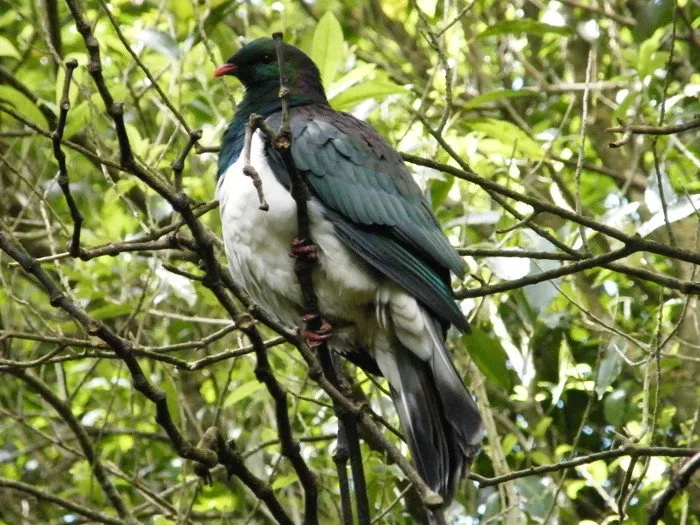
Another native bird that can be seen during the warmer season is the ruru, a.k.a. morepork (Ninox novaeseelandiae), a spotted owl native to New Zealand and Tasmania. I have to admit, I have never seen this bird myself, but according to my mom, in the summer it can be seen quite often in the evening, sitting on the branches hooting. Supposedly its call resembles a vendor advertising "more pork!" I don't know about that, but I think its amazing to be living in a place where it is not uncommon to see an owl in the evenings.
Finally, I should mention the kaka (Nestor meridionalis), a native parrot of New Zealand, who is supposed to be quite rare, occurring only in a few spots throughout the North and South Islands, the Bay of Plenty not even being listed. However, just a few weeks ago while we were having our morning coffee, my mom pointed out a “new bird”, one she hadn’t seen in her garden before, or since. I was there, however, and from the way it looked, and the way it moved, it looked like a big reddish-brown parrot, and was without a doubt a kaka. We were so thrilled!
From Australia and the Wider Region
Of course there are a number of birds present, who not only call New Zealand their home, but also Australia, the South Pacific, or even Southeast Asia. Some of them have been introduced by humans, and are considered less welcome, other have lived in these regions for times before humans, and are considered native. Then there are birds that have spread naturally, by being blown over here in a storm, though it happened relatively recently. One such species is the wax-eye (Zosterops lateralis), called tauhou in Maori, meaning “new arrival”. It came from Australia in the 19th century, and has been native ever since. Being a small bodied bird with an olive-green head and a distinct white circle around its eyes, it’s also one of my mom’s favorites.
Another similarly tiny bird that can be seen all over Whakatane is the New Zealand fantail (Rhipidura fuliginosa). There are fantails from the Pacific Islands to Australia, and all the way to Northern India, but this one is the only species in New Zealand, and locally it's one of the most common birds. Most notable is its playful flight, zig-zagging through the air, and approaching humans, just before turning around again, only to land on a tree and mockingly spreading its tail like a fan. Hence the name.
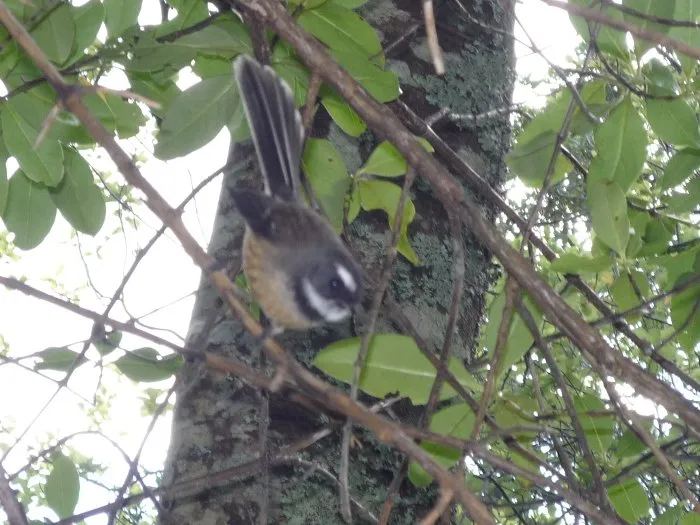
A slightly rare and elusive bird, which gives reason for much joy when spotted, is the sacred kingfisher or kotare (Todiramphus sanctus). I have never managed to see one so far, but my parents have told me with much excitement that it comes around once in a while. Its bright blue plumage makes it stick out easily, even from afar, and even for its small size. Since kingfishers are native in almost all of the world, no one can argue that it should not be part of the New Zealand fauna, and it has a favored position among my mom’s avian visitors.
A bird that’s commonly considered an invasive species in both Australia and New Zealand, is the common myna (Acridotheres tristis), brought in from Southeast Asia. My mom doesn’t mind this funny looking bird, who she calls “the constable”, as it seems to patrol the grounds in its brown uniform with yellow boots, watching out for any disturbance to the peace. In case of anything suspicious, such as an approaching cat, or someone turning their head too quickly, it breaks out in an alarming call, letting all the other birds know that something isn’t quite right.
Another bird that is also not very welcome in New Zealand is the Australian magpie (Gymnorhina tibicen). It was introduced in the 19th century from Victoria as a pest control, and is alleged to harass tui and kereru hatchlings. However, it seems to me that their numbers are much lower, at least around here, than these native birds, and Wikipedia also agrees that these stories are based merely on anecdotal evidence. Personally I love to see these pretty black-and-white feathered birds, looking similar, yet distinct from magpies I know from Europe and North America.
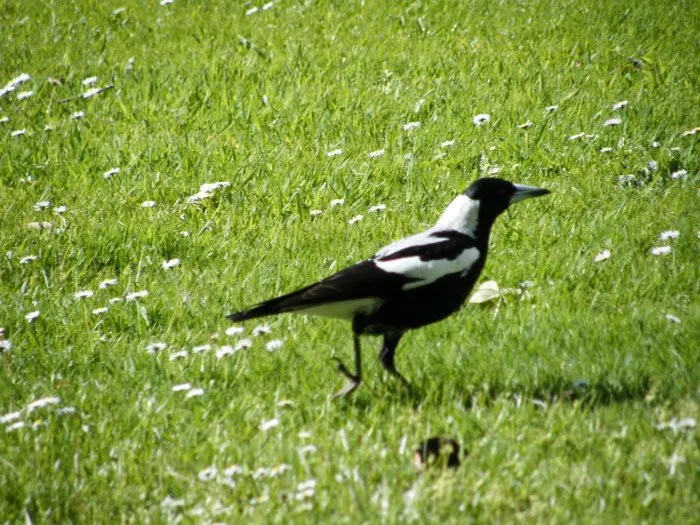
Finally, I want to name the most colorful immigrant from Australia, the eastern rosella (Platycercus eximius). These red-yellow-blue-and-green parrots come in pairs and like to snack on the fresh shoots of the trees. Their many colors make this parrot a welcome sight.

Birds on the Periphery
Not all the birds come into the garden, but you can see and hear them close by. Just behind my parents’ house is a valley, used for storm-water catchment. This is a place where locals walk their dogs whenever it is not flooded. After some heavy rains, however, this area is a favorite place for wild Canada geese (Branta canadensis), who fill the air with their loud calls and honks.
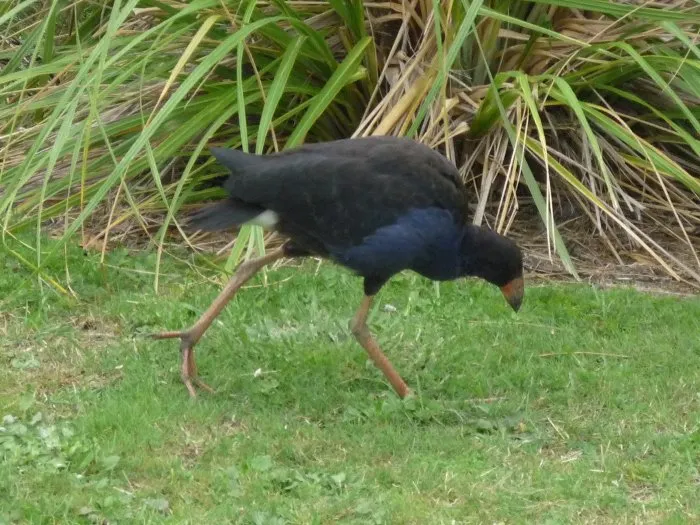
Other aquatic birds that can be found in the near vicinity, though not in the garden itself, is the wild duck or mallard (Anas platyrhynchos), and the native pukeko or Australian swamphen (Porphyrio melanotus), a funny, long legged aquatic bird, seen usually around ponds and marshes. Finally, there is one guy who is usually heard, but not seen: the common pheasant (Phasianus colchicus). While mostly shy to show itself, its distinct crow leaves no doubt that he is around. Last time I was here, I managed to get one in front of my lens.

Leaving the immediate periphery, the list could go on to include seagulls and oyster catchers on the beach, still just a few minutes walk away, or the stereotypical kiwi, supposedly living in the Ohope Scenic Reserve I hiked through the other day. But even just listing the birds in my mom’s garden made this post longer than usual, so maybe this is where I should stop. Fact is, New Zealand is perfect for birds, and people who enjoy spotting them.
Take a Look at the Rest of my Series Wonders of Whakatane:
- An Excursion to the Origins
- On the Footsteps of Toi
- The Ohope Scenic Reserve
- White Island, Where the Devil Goes on Vacation
- Birds in my Mom’s Garden
- Nativism, a Destructive Form of Environmentalism
- The World's First Vertigraph
- Local Murals of Whakatane
- The Deeds of Legendary Maui
Please check out these great communities I'm contributing to:

#ecotrain | What is EcoTrain | Discord Community

#tribesteemup |The 8 Pillars of @TribeSteemUp


#cyclefeed | Introducing CycleFeed | Discord Community